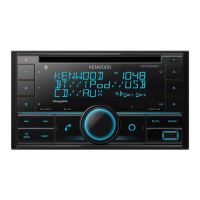W
William WilliamsSep 1, 2025
What to do if my Kenwood DPX505BT Car Receiver displays “NA FILE”?
- NNathan SellersSep 1, 2025
If your Kenwood Car Receiver displays “NA FILE”, ensure that the media (disc/USB) contains supported audio files.

What to do if my Kenwood DPX505BT Car Receiver displays “NA FILE”?
If your Kenwood Car Receiver displays “NA FILE”, ensure that the media (disc/USB) contains supported audio files.
What to do if my Kenwood DPX505BT displays “TOC ERROR”?
If your Kenwood Car Receiver displays “TOC ERROR”, make sure the disc is clean and inserted properly.
What to do if my Kenwood DPX505BT displays “NO DISC”?
If your Kenwood Car Receiver displays “NO DISC”, insert a playable disc into the loading slot.
What does “UNRESPONSIVE DEVICE” mean on Kenwood Car Receiver and how to solve it?
If your Kenwood Car Receiver displays “UNRESPONSIVE DEVICE”, ensure the USB device is functioning correctly and then reattach it.
What does “USB HUB IS NOT SUPPORTED” mean on my Kenwood Car Receiver and how to fix it?
If your Kenwood Car Receiver shows “USB HUB IS NOT SUPPORTED”, it means the unit does not support USB devices connected via a USB hub. Also, the USB port might be drawing more power than the design limit. Turn the power off, unplug the USB device, then turn the power back on and reattach the USB device. If the problem persists, try turning the power off and on or resetting the unit before trying another USB device.
Why is there echo or noise during phone calls on my Kenwood Car Receiver?
If you experience echo or noise during phone conversations on your Kenwood Car Receiver, try adjusting the microphone unit’s position. Also, check the [ECHO CANCEL] setting.
Why can't I pair my Bluetooth device with my Kenwood DPX505BT Car Receiver?
If you are unable to pair your Bluetooth device with your Kenwood Car Receiver, ensure you have entered the same PIN code on both devices. You can also try deleting pairing information from both the unit and the Bluetooth device, then perform pairing again.
Why is my Bluetooth device not detected by my Kenwood DPX505BT Car Receiver?
If your Bluetooth device is not being detected by your Kenwood Car Receiver, try searching from the Bluetooth device again. You can also try to reset the unit.
Why is my iPod/iPhone not working with my Kenwood DPX505BT?
If your iPod/iPhone is not working with your Kenwood Car Receiver, check the connection between the unit and your device. You can also try disconnecting and resetting the iPod/iPhone using a hard reset.
What to do if my Kenwood DPX505BT displays “UNSUPPORTED DEVICE”?
If your Kenwood Car Receiver displays “UNSUPPORTED DEVICE”, verify that the connected USB device is compatible with the unit and that its file systems are in a supported format. You can also try reattaching the USB device.
| Bluetooth | Yes |
|---|---|
| USB Ports | 1 |
| Auxiliary Input | Yes |
| CD Playback | Yes |
| AM/FM Tuner | Yes |
| Built-in Amplifier | Yes |
| Subwoofer Output | Yes |
| MP3 Playback | Yes |
| WMA Playback | Yes |
| AAC Playback | Yes |
| FLAC Playback | Yes |
| SIRI Eyes Free | Yes |
| Android Music Playback | Yes |
| Pandora Control | Yes |
| Spotify Control | Yes |
| Equalizer | Yes |
| Power Output | 50 Watts x 4 Channels |
| DIN Size | 2 DIN |
| EQ | 13-Band |
| Compatible Audio Formats | MP3, WMA, AAC |
| Preamp Outputs | 3 (Front, Rear, Subwoofer) |
| RMS Power Output | 22W x 4 |
| Preamp Voltage | 2.5 volts |
Essential safety warnings and cautions before operating the unit.
Identification of the unit's buttons, display, and remote control.
Steps for language, clock, date, and basic system settings.
Procedures for updating the unit's firmware and restoring default settings.
Tuning radio stations and playing CDs, USB, and iPod/iPhone media.
Connecting and listening to satellite radio, auxiliary input, and Bluetooth audio.
Setting up and using Alexa for voice commands and information.
Adjusting sound settings, equalizer, and display appearance.
Safety precautions, parts, and wiring diagrams for installation.
Unit care, common issue resolution, and maintenance guides.
Detailed specifications for the unit's components and features.
